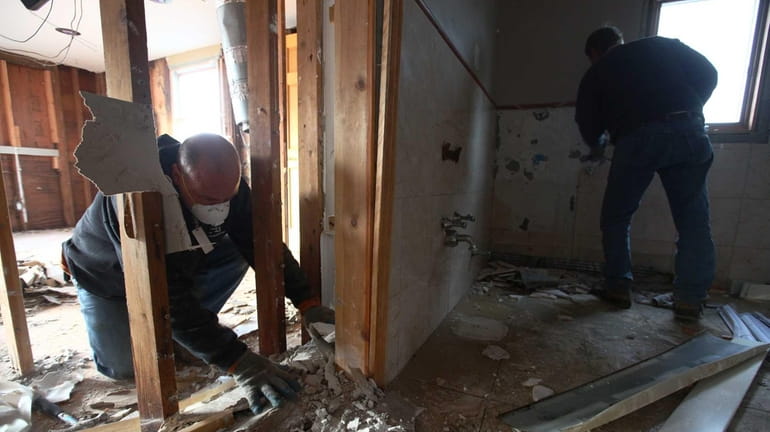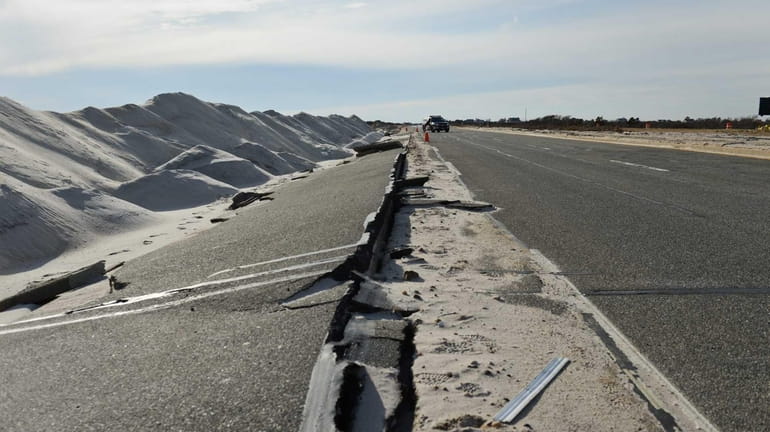Mold in flooded houses poses health hazard

David McGoogan, left, and Christopher Welch, who are both Crisis Response International volunteers, tear apart wet and moldy walls in Michael McPeak's home in Lindenhurst. (Nov. 20, 2012) Credit: Jessica Rotkiewicz
The first floor of Steve Gennusa's Island Park home was filled with 4 feet of water during superstorm Sandy. Now that the water has receded, it's covered in another unwelcome intruder: mold.
"It's on the kitchen cabinets, the wood floor, the TV cabinet," he said. The carpet in his garage, still partially filled with floodwater, is also covered in dark green fungus.
That, plus the sewage that came up from his tub and toilet, has made the house uninhabitable. Gennusa said he spent one night there, but the next morning, he felt nauseated, dizzy and even blacked out at one point. Now he enters the house wearing a mask.
Molds, which thrive in moist places, are found everywhere in nature but, when concentrated inside a building, can be a health hazard. Their airborne spores -- alive or dead -- can cause breathing problems, rashes or an asthma attack.
Dr. Maureen Lichtveld, chair of Tulane University's department of global environmental health sciences, said children are particularly vulnerable, especially if they are also exposed to other allergens such as cat fur or tobacco smoke.
"You need to look at mold as an addition to that 'salad,' not only in isolation," said Lichtveld, who has done research on mold.
If it's moldy, clean or toss
Anything covered in mold needs to be thrown out, ripped out or thoroughly cleaned, experts say. But there are right ways and wrong ways to do the cleanup. And there may be times when getting a knowledgeable contractor to do the job is the smart thing to do.
"People need to use a bit of caution," said Dr. Georges Benjamin, executive director of the American Public Health Association. Anyone who has allergies or asthma should not be part of the cleanup and anyone doing cleanup should be properly dressed, he said.
That means wearing an N-95 respirator or mask, according to the U.S. Environmental Protection Agency. A dust mask or handkerchief won't prevent mold spores from passing through, the EPA says. Available at most hardware stores or online, the disposable versions can start at $12.
Anyone doing cleanup should also wear goggles without vent holes to prevent spores from getting in their eyes; long rubber gloves; long pants; a long-sleeved shirt; and boots or work shoes, the EPA says.
Anything porous that was wet with floodwater and can't be cleaned should be bagged and thrown away, the agency says. That includes upholstered furniture, carpeting, wallboard and insulation.
"The issue with mold is that once it gets into certain materials like carpeting or Sheetrock, even if it appears dry, you may not get rid of the mold and it's probably better to rip it out," said Amy Juchatz, an environmental toxicologist for the Suffolk County Department of Health Services. Juchatz said that mold can get behind walls -- another reason to rip them out if the room was filled with water.
Detergent on hard surfaces
The EPA says hard surfaces can be cleaned with a detergent -- such as dish-cleaning liquid -- or with a cleanser that kills germs. The New York State Department of Health recommends using a 10 percent bleach solution.
If it's a big job or if the water and mold damage was caused by sewage or contaminated water, consider hiring a professional, the EPA says.
Mold removal is not typically covered by homeowner's insurance, "unless it is a consequence of a covered loss, such as a burst water pipe or wind-driven rain," said Michael Barry, a spokesman for the Insurance Information Institute in Manhattan. But policies can vary and policyholders should contact their insurers if they are unsure, he said.
Flood insurance also does not cover mold cleanup, said a spokesman for the Federal Emergency Management Agency. But homeowners may qualify for assistance from a federal program or volunteer agencies, the spokesman said. Residents who have had flood damage should register with FEMA.
The state doesn't license building contractors, including mold contractors. But the state Department of Health suggests checking whether the contractor complies with EPA's lead paint rules and whether he is a licensed New York asbestos contractor. "If the contractor follows the requirements for lead paint and asbestos cleanup, then they will also prevent the spread of mold and dust in your home," the health department said.
Certification recommended
Rachel Adams, an instructor for the Institute for Inspection, Cleaning and Restoration Certification, a nonprofit that sets industry standards, said the cleaning company should be certified by the institute. That means the company has been trained not just in getting rid of mold but also in containing its spread to other parts of the house, she said.
Jason Brand, owner of DASO Cleaning and Restoration Inc. in Plainview, said mold removal in a typical Long Island basement of 800 to 1,000 square feet would cost between $8,000 and $15,000.
Brand -- like Adams -- also recommends that the contractor test indoor air quality compared with outdoor mold levels before and after mold cleanup and that the results be sent to an independent lab. Each test costs about $150 per sample; the minimum for one room would generally be $600, he said.
The EPA says sampling "may be useful" to determine if an area has been adequately cleaned but should be done by professionals who follow protocols set by the American Industrial Hygiene Association or the American Conference of Governmental Hygienists.
But Suffolk's Juchatz said "we typically recommend against" testing. No federal limits have been set on mold or mold spores, she said, and even low levels of mold might be a problem for some people.
Tulane's Lichtveld agreed.
"There really isn't a safe level," she said. Testing might give some people "more comfort," she said, but "it is not something that is needed."
How to get rid of mold
What to wear
What to discard
How to clean
When to call a professional
Learn more
U.S. Environmental Protection Agency
http://www.epa.gov/iaq/flood/index.html; www.epa.gov/mold; http://www.epa.gov/mold/mold_remediation.html
U.S. Centers for Disease Control and Prevention http://www.cdc.gov/mmwr/preview/mmwrhtml/rr5508a1.htm
New York State Department of Health
http://www.health.ny.gov/publications/7287
Institute for Inspection Cleaning and Restoration Certification
http://iicrc.org/consumers/care/mold-remediation/
Feral cat found with rabies . . . Piano Man's last show . . . Travel to Block Island . . . Olympics opening ceremony
Feral cat found with rabies . . . Piano Man's last show . . . Travel to Block Island . . . Olympics opening ceremony



